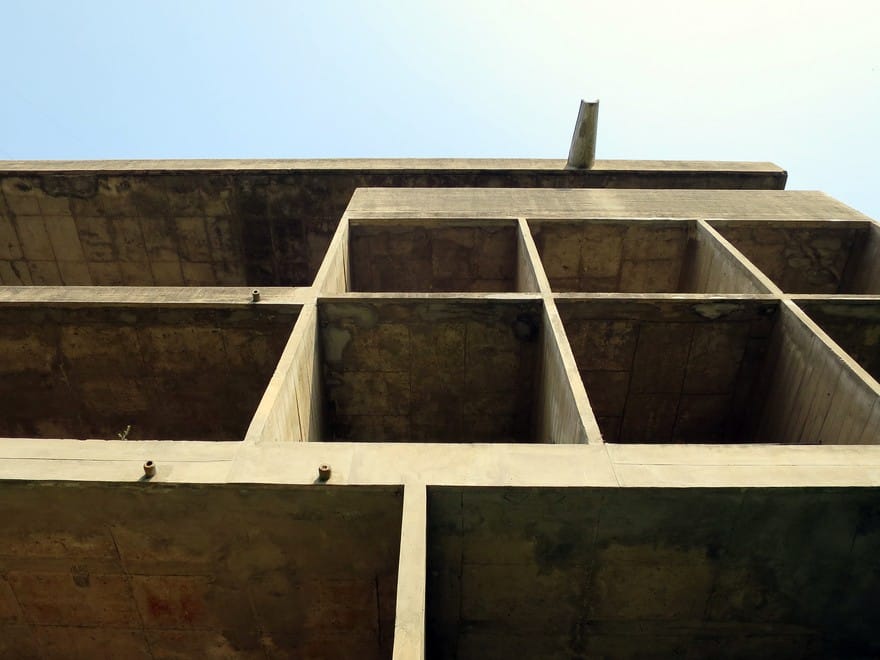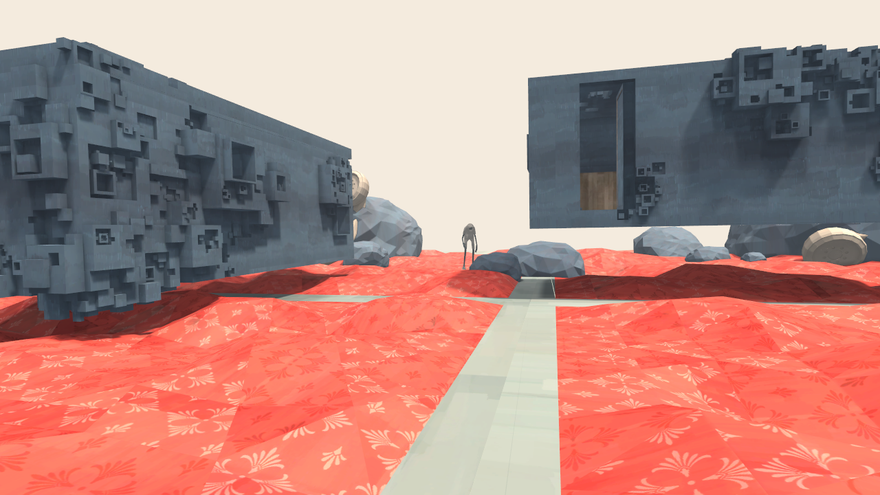Studio Oleomingus wants to take us to an impossible Somewhere

Header illustration by Jordan Rosenberg
///
Somewhere on the coast of the Western India, Dhruv TK sits quietly at his desk just a couple miles from the coast of the Arabian Sea. Sometimes he dreams of places unknown, uninhabited, uncreated. He pulls inspiration from the fantastical design of paper architect Lebbeus Woods whose magical structures would never come to be … except perhaps in Dhruv’s digital imagination. Somewhere.
And across the world a programmer named Kevin Vargas is filtering Dhruv’s thoughts into code, pulling together Dhruv’s experience as an exhibition design student at the National Institute of Design of Ahmedabad, and shaping the dreams of a 25-year-old son of an architect. In a creative turn only possible in a digital medium, they met on a message forum but have yet to meet face-to-face. Somewhere.
“I’m probably mangling history a lot”
And Dhruv is plucking through the pages of a poetry collection by nonsense poet Sukumar Ray. Wordygurdyboom, Ray says, rolling off the page with madness and mirth and prose that would make Lewis Caroll rollick with delight. Dhruv wants to channel that sense of impropriety and playfulness into something, a game perhaps. “Storytelling in spaces,” he tells me. Somewhere.
And during his walks to class in the former textile giant of Ahmedabad, the largest city and former capital of the Indian state of Gujarat, he is confronted with the frightening majesty writ small in the designs of a French architect named Le Corbusier. The Frenchman had come to India to design every aspect of the planning of his dream city of Chandigarh, a city over 700 miles north of Dhruv. Somewhere.

And yet, Le Corbusier fortuitously made his mark in Dhruv’s hometown, leaving a spate of personal buildings. And there is one in particular that captured Dhruv’s eye: Villa Shodhan. A modernist and geometric marvel, Le Corbusier incorporated elements of local Ahmedabad design and Le Corbusier’s own unmistakable angularity. “He works such bizarre forms,” Dhruv says. “The way he cuts across geometry, the massive ramps cutting through door frames, or how he can make the facades in one continuous form. Oh, and the windows!” Somewhere.
And if you were blend of all of these things—the lilt of Ahmedabad, the gravity of Le Corbusier, the madness of Ray, and Dhruv’s own obsession with designing physical spaces—you would arrive at this magical thing. It’s called Somewhere.
games like Somewhere make the intangible tangible
The debut title from Studio Oleomingus, Somewhere is a first-person exploration game set in India around 1910. It is a country on the brink of revolution, set before the wars and just three decades before India would become a sovereign nation, free of British rule. “I’m not making a historical comment through the game,” Dhruv says. “I’m probably mangling history a lot.”
But what a sweet mangling it is. You flip characters in Somewhere and each transition gives you a different perspective, a different on lens on the world. You travel by becoming others, and as you shift identities, each person you become gives you a broader picture. In the initial alpha build titled “Rituals,” you encounter a man who was running away from his military post, but it wasn’t until you swapped into his body that you understood why. It’s probably best to think of Somewhere as a collection of shorts, fragments of a mirror that each give their own distorted and biased opinion of a larger visage. With a Borgesian nod, Dhruv explains, “to figure out the telling of stories starts with the story itself.”

And, of course, Oleomingus’ trademark is the space itself. The angles and shadows come to life in low-poly, with a muted and restrained palette that demands exploration. Dhruv’s father was an architect and he remembers playing at those construction sites two decades ago. “Running up the stairs, pebbles and grit,” he says. “It was my playground.” Just as children recreate homes and public spaces with their imagination and freedom of society’s conventions (how else to explain the inexplicable footprints beneath the coffee table of a young parent’s home?), Dhruv desires that Somewhere inspires those same feelings of freedom, even if a false one, inside his tightly-constructed universe.
But unlike the architectural constraints of his father and his own as an exhibition design student, Dhruv was able to abandon what is possible in physical space for spatial nonlinearity. “You don’t plan out human movement the way you plan out player movement,” he says. “The spaces are substantially different.” This was the dream of one of Dhruv’s idols, Lebbeus Woods, who created wild and unreasonable structures that existed only on paper. Our interactions with Woods’ impossible structures are bounded by what we can dream, but games like Somewhere make the intangible tangible. “The most fun part is to make nonlinear space,” he says. “You don’t know how you end up in one room.”
Villa Shodhan via Flickr



